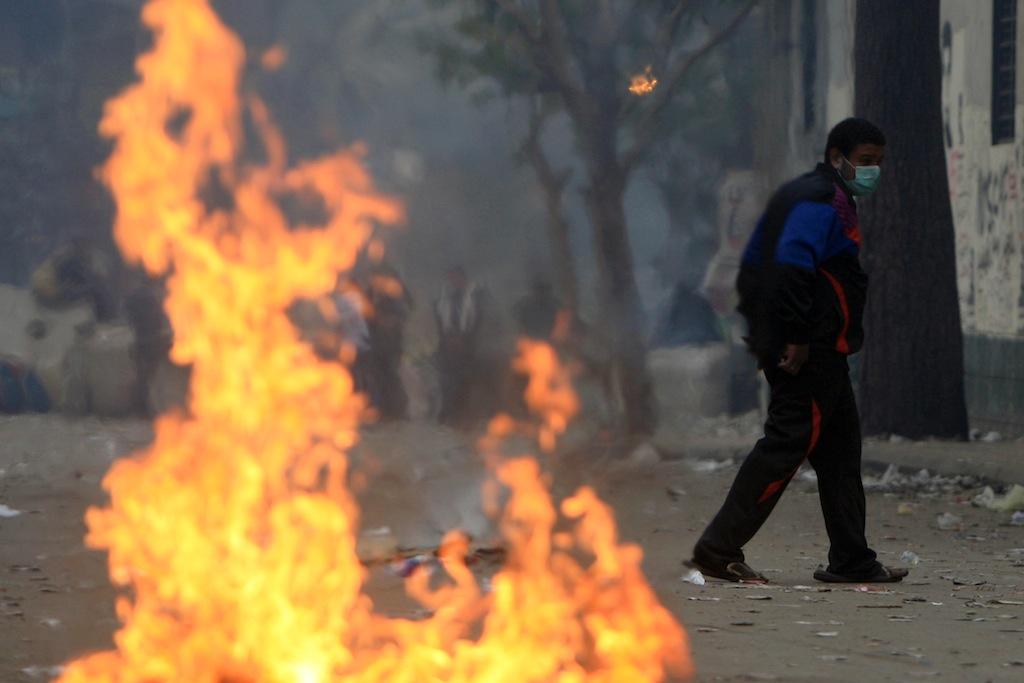Cairo clashes leave downtown streets in rubble
An Egyptian protester walks past flames during clashes with riot police near the interior ministry in the capital Cairo.
Entering Tahrir Square, the chest almost immediately constricts.
The severe amount of tear gas fired into the vicinty of the square in the past few days assaults the senses.
Clouds of the potent smoke, fired by police to disperse demonstrators outside Egypt's interior ministry, hang over downtown Cairo's colonial-era plazas.
It's been five days since demonstrators marched on the ministry of interior to protest police inaction during a football riot that left at least 76 dead last week in the Suez canal town of Port Said.
More from GlobalPost: Egypt: Soccer riot witnesses recount horrific violence (VIDEO)
The march quickly deteriorated into clashes with police stationed in the streets leading to the ministry building, several blocks from Tahrir. At least 13 people have been killed.
Cairo's downtown streets now resemble more of a war zone than a dirtied, crumbling testament to the capital's Belle Époque. On one sidestreet on the way to the ministry, fires burn in small clusters on the debris-littered pavement, lit to keep protestors warm as they held out against police overnight.
The police have built a new concrete wall — the seventh of its kind put-up in the capital since Nov. 2011 — further down the street to block demonstrators from reaching the ministry.
A young man wants to show us blood stains on the pavement. The weapons of choice for both sides have so far been large rocks, molotov cocktails, birdshot and tear gas.
"Go from here, you are ruining the country," 65-year-old El Sayed El Khory, a downtown resident, shouted at a young female protestor.
But the seemingly anti-protestor resident soon turned his anger toward the Supreme Council of Armed Forces (SCAF), the group of armed generals that have presided over a rocky, unfinished transition to democratic rule.
More from GlobalPost: Egypt's Unfinished Revolution: Revisiting Tahrir Square
"This was all planned for by SCAF," he said. "They planned for Port Said so that people would come here and fight the police, and they could keep power."
"It's because people want the miltiary to give power to the parliament," he said, referring to the newly-elected People's Assembly.
When Egyptians rose up en masse a year ago, it was no mistake that on the third day of the revolt — Jan. 28, 2011 — they burned over 100 police stations.
The police force was known for its corruption and all-too-often reliance on torture to browbeat detainees and intimidate generally the population.
Police reform was at the heart of the uprising that toppled Egyptian President, Hosni Mubarak, but many Egyptians here say nothing has changed.
"We are protesting because we have been living in this unfair situation for over 30 years. It must stop," said Soma Abdel Raziq, a 47-year-old mother of three, defying the stereotype of the young, dissaffected male protestor.
"The police, they are Egyptians. They are our children, too," she said, adjusting the flimsy, blue surgical mask she bought to protect herself from the tear gas. "But it's time to take back our rights."
The World is an independent newsroom. We’re not funded by billionaires; instead, we rely on readers and listeners like you. As a listener, you’re a crucial part of our team and our global community. Your support is vital to running our nonprofit newsroom, and we can’t do this work without you. Will you support The World with a gift today? Donations made between now and Dec. 31 will be matched 1:1. Thanks for investing in our work!
